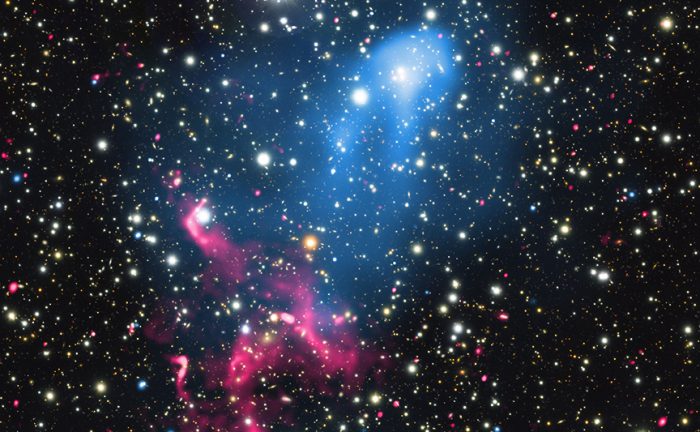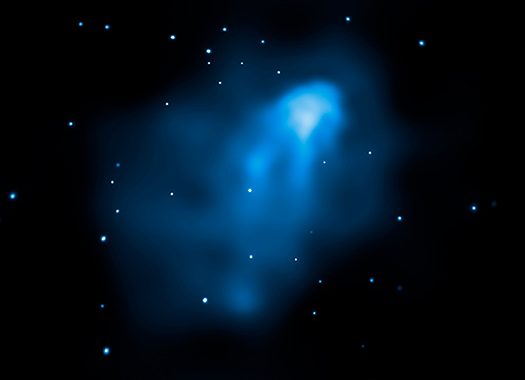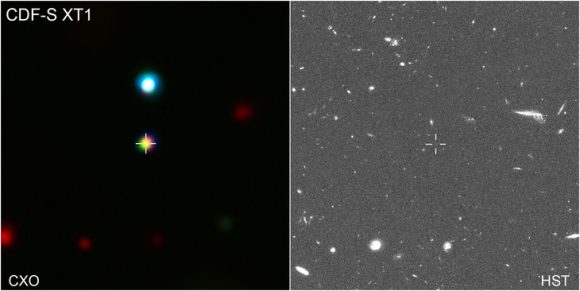

Johns Hopkins University (JHU) continues to pad its space community résumé with their interactive map, “The map of the observable Universe”, that takes viewers on a 13.7-billion-year-old tour of the cosmos from the present to the moments after the Big Bang. While JHU is responsible for creating the site, additional contributions were made by NASA, the European Space Agency, the National Science Foundation, and the Sloan Foundation.

An artist’s impression of ROSAT, a satellite X-ray telescope launched 1 June 1990,
on what was initially designed as an 18-month mission. ROSAT actually operated until 12 February 1999
and re-entered the Earth’s atmosphere on 23 October 2011.
Image credit: DLR.

This projection shows the sky distribution of 2RXS sources in Galactic coordinates.
The size of each dot scales with the source count rate (brightness) and the colour represents the X-ray colour.
Image credit: © MPE. Scientists at the Max Planck Institute for Extraterrestrial Physics (MPE) have revisited the all-sky survey carried out by the ROSAT satellite,
to create a new image of the sky in at X-ray wavelengths. Along with this a revised and extended version of the catalogue
of bright and faint point-like sources will be released. The now published “2RXS catalogue” provides the deepest and cleanest X-ray
all-sky survey to date, which will only be superseded with the launch of the next generation X-ray survey satellite,
eROSITA, currently being completed at MPE.

Japan's Astro-H X-ray observatory launches from Tanegashima Space Center on Feb. 17, 2016. Credit: JAXA via NASA There's a new set of X-ray eyes in the sky. The Japan Aerospace Exploration Agency's (JAXA) Astro-H X-ray observatory launched to Earth orbit
today (Feb. 17) at 3:45 a.m. EST (0845 GMT; 5:45 p.m. local time in Japan) atop an H-IIA rocket from the Tanegashima Space Center. Astro-H separated from the rocket about 14 minutes after liftoff. The satellite's solar arrays deployed as planned,
and the spacecraft is currently in good health, JAXA officials said. [ - See more

This illustration shows the locations and energy ranges of Astro-H science instruments and their associated telescopes. One keV equals 1,000 electron volts, which is hundreds of times the energy of visible light. Credit: JAXA/NASA's Goddard Space Flight Center SEE MORE

Chikara Harada, right, head of the Space Tracking and Communications Center of the Japan Aerospace Exploration Agency (JAXA),
responds to a question in a news conference in Tokyo on April 28 while using a model of an X-ray astronomy satellite Hitomi.
Next to him is Saku Tsuneta, director of JAXA’s Institute of Space and Astronautical Science. (Wataru Sekita)

This image of the supernova remnant Cassiopeia A combines some of the first X-ray data collected by NASA’s Imaging X-ray Polarimetry Explorer, shown in magenta, with high-energy X-ray data from NASA’s Chandra X-Ray Observatory, in blue. Credits: NASA/CXC/SAO/IXPE

This image from NASA’s Imaging X-ray Polarimetry Explorer maps the intensity of X-rays coming from the observatory’s first target, the supernova remnant Cassiopeia A. Colors ranging from cool purple and blue to red and hot white correspond with the increasing brightness of the X-rays. The image was created using X-ray data collected by IXPE between Jan. 11-18. Credits: NASA
The Chandra X-RAY OBSERVATRY



July 23, 2014 marks the 15th anniversary of the launch of the Chandra X-ray Observatory. Launched aboard the Space Shuttle Columbia from Kennedy Space Center on July 23, 1999, Chandra took its place among NASA’s “Great Observatories” and with its unique capability for producing sub-arcsecond X-ray images, it has revealed stunning discovery after stunning discovery. The Chandra program is managed by NASA’s Marshall Space Flight Center in Huntsville, Alabama and is operated by the Smithsonian's Astrophysical Observatory in Cambridge, Massachusetts. Image credit: NASA Last Updated: July 30, 2015 Editor: Lee Mohon

This 70mm frame shows the 50,162-pound Chandra X-ray Observatory before it was tilted upward for its release from the Space Shuttle Columbia's payload bay on July 23, 1999, just a few hours following the shuttle's arrival in Earth orbit. Chandra was spring-ejected from a cradle in the payload bay at 6:47 a.m. Central time. Commander Eileen Collins, the first female Shuttle Commander, maneuvered Columbia to a safe distance away from the telescope as an internal timer counted down to the first of a two-phase ignition of the solid-fuel Inertial Upper Stage (IUS). The IUS lit up as scheduled at 7:47 a.m., and a few minutes later, shut down as planned, sending Chandra on a highly elliptical orbit which was refined over the next few weeks by a series of firings of telescope thrusters, designed to place Chandra in an orbit about 6900 x 87,000 statute miles above the Earth.
In August 2015, Chandra will pass the 16th anniversary of another milestone in the mission – the release of the “First Light” images from the telescope. As of July 1st, 2015, Chandra has traveled over 17 billion miles while completing about 2,200 orbits of the Earth. Chandra has made over 14,000 observations over the last 16 years. The targets include objects as close as the Earth and as distant as black holes near the edge of the observable universe.Image Credit: NASA/JSC

Artist illustration of the Chandra X-ray Observatory, the most sensitive X-ray telescope ever built. Credit: NASA/CXC/NGST

When the star that created this supernova remnant exploded in 1572, it was so bright that it was visible during the day. And though he wasn’t the first or only person to observe this stellar spectacle, the Danish astronomer Tycho Brahe wrote a book about his extensive observations of the event, gaining the honor of it being named after him. In modern times, astronomers have observed the debris field from this explosion − what is now known as Tycho’s supernova remnant using data from NASA’s Chandra X-ray Observatory, the NSF’s Karl G. Jansky Very Large Array (VLA) and many other telescopes. Today, they know that the Tycho remnant was created by the explosion of a white dwarf star, making it part of the so-called Type Ia class of supernovas used to track the expansion of the Universe. Since much of the material being flung out from the shattered star has been heated by shock waves − similar to sonic booms from supersonic planes − passing through it, the remnant glows strongly in X-ray light. Astronomers have now used Chandra observations from 2000 through 2015 to create the longest movie of the Tycho remnant’s X-ray evolution over time, using five different images. This shows the expansion from the explosion is still continuing about 450 years later, as seen from Earth’s vantage point roughly 10,000 light years away. By combining the X-ray data with some 30 years of observations in radio waves with the VLA, astronomers have also produced a movie, using three different images. Astronomers have used these X-ray and radio data to learn new things about this supernova and its remnant. The researchers measured the speed of the blast wave at many different locations around the remnant. The large size of the remnant enables this motion to be measured with relatively high precision. Although the remnant is approximately circular, there are clear differences in the speed of the blast wave in different regions. The speed in the right and lower right directions is about twice as large as that in the left and the upper left directions. This difference was also seen in earlier observations. This range in speed of the blast wave’s outward motion is caused by differences in the density of gas surrounding the supernova remnant. This causes an offset in position of the explosion site from the geometric center, determined by locating the center of the circular remnant. The astronomers found that the size of the offset is about 10% of the remnant’s current radius, towards the upper left of the geometric center. The team also found that the maximum speed of the blast wave is about 12 million miles per hour. Offsets such as this between the explosion center and the geometric center could exist in other supernova remnants. Understanding the location of the explosion center for Type Ia supernovas is important because it narrows the search region for a surviving companion star. Any surviving companion star would help identify the trigger mechanism for the supernova, showing that the white dwarf pulled material from the companion star until it reached a critical mass and exploded. The lack of a companion star would favor the other main trigger mechanism, where two white dwarfs merge causing the critical mass to be exceeded, leaving no star behind. The significant offset from the center of the explosion to the remnant’s geometric center is a relatively recent phenomenon. For the first few hundred years of the remnant, the explosion’s shock was so powerful that the density of gas it was running into did not affect its motion. The density discrepancy from the left side to the right has increased as the shock moved outwards, causing the offset in position between the explosion center and the geometric center to grow with time. So, if future X-ray astronomers, say 1,000 years from now, do the same observation, they should find a much larger offset. A paper describing these results has been accepted for publication in The Astrophysical Journal Letters and is available online. The authors are Brian Williams (NASA's Goddard Space Flight Center and Universities Space Research Association), Laura Chomiuk (Michigan State University), John Hewitt (University of North Florida), John Blondin (North Carolina State University), Kazimierz Borkowski (NCSU), Parviz Ghavamian (Towson University), Robert Petre (GSFC), and Stephen Reynolds (NCSU). NASA's Marshall Space Flight Center in Huntsville, Alabama, manages the Chandra program for NASA's Science Mission Directorate in Washington. The Smithsonian Astrophysical Observatory in Cambridge, Massachusetts, controls Chandra's science and flight operations. Image credits: X-ray: NASA/CXC/GSFC/B. Williams et al; Optical: DSS; Radio: NSF/NRAO/VLA Read More from NASA's Chandra X-ray Observatory. For more Chandra images, multimedia and related materials, visit: Last Updated: May 13, 2016 Editor: Lee Mohon

A composite image of the Tycho supernova remnant, showing its “lumpy” nature as revealed by NASA’s Chandra X-ray Observatory. Image: X-ray: NASA/CXC/RIKEN & GSFC/T. Sato et al; Optical: DSS
In 1572, the Danish astronomer Tycho Brahe was among those who noticed a "new star" in the constellation of Cassiopeia. Astronomers now know that this object was not new at all — it instead signaled the death of star in a supernova. The Tycho supernova remnant is from a "Type Ia" supernova where a white dwarf star explodes after exceeding a critical mass. Over 400 years later, data from NASA's Chandra X-ray Observatory reveals a clumpy and lumpy pattern of bright and fainter regions in the stellar debris. Scientists compared the Chandra data to theoretical computer simulations to try to determine where these clumps came from. Their research reveals the supernova itself was likely responsible, suggesting the explosion may have detonated in multiple spots on the star. Understanding the details of Type Ia supernovas is important because astronomers use them as "standard candles" for studying the Universe on large scales.

Press Image and Caption An unparalleled image from NASA's Chandra X-ray Observatory gives astronomers the best look yet at the growth of black holes over billions of years beginning soon after the Big Bang. This is the deepest X-ray image ever obtained, collected with about 7 million seconds, or eleven and a half weeks, of Chandra observing time. The image comes from what is known as the Chandra Deep Field-South. The central region of the image contains the highest concentration of supermassive black holes ever seen, equivalent to about 5,000 objects that would fit into the area of the full Moon and about a billion over the entire sky. Credit: X-ray: NASA/CXC/Penn State/B.Luo et al. Images and a podcast about the findings are available at: For more Chandra images, multimedia and related materials, visit: Media contacts: Megan Watzke Chandra X-ray Center, Cambridge, Mass. 617-496-7998 Megan Watzke

Three orbiting X-ray space telescopes have detected an increased rate of X-ray flares from the usually quiet giant black hole at the center
of our Milky Way galaxy after new long-term monitoring. Scientists are trying to learn whether this is normal behavior that was unnoticed due
to limited monitoring, or these flares are triggered by the recent close passage of a mysterious, dusty object. By combining information from long monitoring campaigns by NASA’s Chandra X-ray Observatory and ESA’s XMM-Newton, with observations by the
Swift satellite, astronomers were able to carefully trace the activity of the Milky Way’s supermassive black hole over the last 15 years.
The supermassive black hole, a.k.a. Sagittarius A*, weighs in at slightly more than 4 million times the mass of the Sun.
X-rays are produced by hot gas flowing toward the black hole. The new study reveals that Sagittarius A* (Sgr A* for short) has been producing one bright X-ray flare about every ten days.
However, within the past year, there has been a ten-fold increase in the rate of bright flares from Sgr A*, at about one every day.
This increase happened soon after the close approach to Sgr A* by a mysterious object called G2.
“For several years, we’ve been tracking the X-ray emission from Sgr A*. This includes also the close passage of this dusty object”
said Gabriele Ponti of the Max Planck Institute for Extraterrestrial Physics in Germany. “A year or so ago, we thought it had absolutely no effect
on Sgr A*, but our new data raise the possibility that that might not be the case."
Originally, astronomers thought G2 was an extended cloud of gas and dust. However, after passing close to Sgr A* in late 2013,
its appearance did not change much, apart from being slightly stretched by the gravity of the black hole.
This led to new theories that G2 was not simply a gas cloud, but instead a star swathed in an extended dusty cocoon.
“There isn’t universal agreement on what G2 is,” said Mark Morris of the University of California at Los Angeles.
“However, the fact that Sgr A* became more active not long after G2 passed by suggests that the matter coming off of G2 might have caused
an increase in the black hole’s feeding rate.” While the timing of G2’s passage with the surge in X-rays from Sgr A* is intriguing astronomers see other black holes that seem to behave
like Sgr A*. Therefore, it’s possible this increased chatter from Sgr A* may be a common trait among black holes and unrelated to G2.
For example, the increased X-ray activity could be due to a change in the strength of winds from nearby massive stars that are feeding material
to the black hole. “It’s too soon to say for sure, but we will be keeping X-ray eyes on Sgr A* in the coming months,” said co-author Barbara De Marco,
also of Max Planck. “Hopefully, new observations will tell us whether G2 is responsible for the changed behavior or if the new flaring is
just part of how the black hole behaves.”
The analysis included 150 Chandra and XMM-Newton observations pointed at the center of the Milky Way over the last 15 years,
extending from September 1999 to November 2014. An increase in the rate and brightness of bright flares from Sgr A* occurred after mid-2014,
several months after the closest approach of G2 to the huge black hole.
If the G2 explanation is correct, the spike in bright X-ray flares would be the first sign of excess material falling onto the black hole because
of the cloud’s close passage. Some gas would likely have been stripped off the cloud, and captured by the gravity of Sgr A*.
It then could have started interacting with hot material flowing towards the black hole, funneling more gas toward the black hole that could later
be consumed by Sgr A*.
A paper on these findings has been accepted by the Monthly Notices of the Royal Astronomical Society. A preprint is available online.
NASA's Marshall Space Flight Center in Huntsville, Alabama, manages the Chandra program for NASA's Science Mission Directorate in Washington.
The Smithsonian Astrophysical Observatory in Cambridge, Massachusetts, controls Chandra's science and flight operations.
Image credit: NASA/CXC/MPE/G. Ponti et al.; Illustration: NASA/CXC/M. Weiss Read More from NASA's Chandra X-ray Observatory. For more Chandra images, multimedia and related materials, visit: Last Updated: Sept. 23, 2015 Editor: Lee Mohon

Composite view of the collision between galaxy clusters Abell 3411 and Abell 3412 . Credit: X-ray: NASA/CXC/SAO/R. van Weeren et al./NAOJ/Subaru

Composite view of the collision between galaxy clusters Abell 3411 and Abell 3412 . Credit: X-ray: NASA/CXC/SAO/R. van Weeren et al./NAOJ/Subaru

Image of radio waves produce by the collision between Abell 3411 and Abell 3412. Credit: NASA/CXC/SAO/R. van Weeren et al. ts/m

A mysterious flash of X-rays has been discovered by NASA’s Chandra X-ray Observatory in the deepest X-ray image ever obtained. Credit: NASA/Chandra/Harvard

X-ray (left) and optical (right) images of the space around the X-ray source, made with Chandra and the Hubble Space Telescope, respectively. Credit: NASA/CXC/F. Bauer et al.

Still image of the X-ray source observed by Chandra, showing the captured flare up at bottom Credit: NASA/CXC/Pontifical Catholic Univ./F.Bauer et al.
Further Reading:Chandra, PennState
CHANDRA OBSERVATORY CHECKS TO MAKE SURE ALPHA CENTAURI IS SAFE, YOU KNOW,
IN CASE WE DECIDE TO VISIT

Still image of the X-ray source observed by Chandra, showing the captured flare up at bottom Credit: NASA/CXC/Pontifical Catholic Univ./F.Bauer et al.

The two brightest stars of the Centaurus constellation – (left) Alpha Centauri and (right) Beta Centauri. The faint red star in the center of the red circle is Proxima Centauri. Credit: Wikipedia Commons/Skatebiker

The respective habitable zones around Alpha Centauri A and B. Credit: Planetary Habitability Laboratory
A night in VLT and ALMA observatories (sound also recorded on location) from Jordi Busque on Vimeo.
The Very Large Telescope (VLT) consists of four individual telescopes, each with a primary mirror 8.2 m across and four movable Auxiliary Telescopes (ATs) of 1.8 m aperture. It is located on cerro Paranal (2635m), in northern Chile.
The Atacama Large Millimeter Array (ALMA) is the largest ground-based astronomical project consisting of 66 12-metre (39 ft), and 7-metre (23 ft) diameter radio telescopes. It is also the world's highest array of radio telescopes at 5,000 metres altitude in the Chajnantor plateau, northern Chile.
Images and sounds recorded on location by Jordi Busqué.
For more information, please visit www.jordibusque.com
As the only X-ray observatory capable of resolving Alpha Centauri A and B during its current close orbital approach, Chandra observed these two main stars every six months for the past thirteen years. These long-term measurements captured a full cycle of increases and decreases in X-ray activity, in much the same way that the Sun has an 11-year sunspot cycle.
At a distance of only 25 trillion miles, the Alpha Centauri star system is a prime target in humanity's search for life outside our Solar System. Astronomers would like to know what kind of environment exists around the two stars in Alpha Centauri that closely resemble our Sun. To learn about this, NASA's Chandra X-ray Observatory has been monitoring the Alpha Centauri system every six months for over a decade. Chandra is the only X-ray observatory capable of resolving the two Sun-like stars to determine which star is doing what. A new study indicates these two stars are likely not pummeling any orbiting planets with large amounts of X-ray radiation. This is promising news for the sustainability of life on any planets astronomers find around these two nearby stars in the future.

This image show half of the X-ray sky, projected onto a circle with the center of the Milky Way on the left and the galactic plane running horizontally. Photons have been colour-coded according to their energy (red for energies 0.3-0.6 keV, green for 0.6-1 keV, blue for 1-2.3 keV). Credit: MPE, J. Sanders for the eROSITA consortium
Das Röntgenteleskop eROSITA, das am Max-Planck-Institut für Extraterrestrische Physik entwickelt und gebaut wurde, ist das Hauptinstrument der russisch-deutschen "Spektrum-Röntgen-Gamma" (SRG) Mission. Am 21. Juni 2019 wird es von Baikonur aus gestartet und 1,5 Millionen Kilometer von der Erde entfernt im Weltraum platziert. Dort soll eROSITA mit bisher unerreichter spektraler und räumlicher Auflösung die erste vollständige Himmelsdurchmusterung im mittleren Röntgenbereich bis 10 keV durchführen, um mehr über die rätselhafte Dunkle Energie zu erfahren. MaxPlanckSociety

eROSITA X-ray image with the newly discovered filament between two galaxy clusters. The distribution of galaxies (white contours, upper left), as seen from the Two Micron All Sky Survey, follows the structure of the filament. In the SLOW simulation, which is tailored to reproduce the main features of the Local Universe, this individual system with both clusters and the filament spine is reproduced as well. Credit: Dietl et al. (2024)

This X-ray image shows the full extent of the Virgo Cluster in X-rays as seen by eROSITA. The bright white spot at the center is the central galaxy M87. The hazy white glow around M87 is the very hot gas between galaxies. It extends out more in some directions than others, and isn’t circular. This is evidence that the Virgo Cluster is still in the process of forming. Credit: McCall al. (2024)
Hi Spacecats, I'm Dr Maggie Lieu and welcome to my channel, where you can find all things space, astronomy and physics! Journey through the universe like never before with eROSITA's groundbreaking first data release! This video unveils the secrets hidden in X-ray light, showcasing the largest ever catalog of cosmic sources (nearly 1 million!) and mind-blowing discoveries like: - 700,000+ supermassive black holes revealed, mapping the universe's hidden giants. - Massive cosmic structures never seen before, pushing the boundaries of our understanding. - Clues to the formation of stars and galaxies, peering into the universe's birthplaces. - Potential impact on the search for habitable planets, uncovering hidden stellar environments. This is more than just data, it's a revolution in X-ray astronomy! Join me as we: -Explore the stunning X-ray images captured by eROSITA. -Break down the key findings and their significance. -Discuss the challenges of this groundbreaking mission. -Answer your burning questions about the universe! Subscribe for more space exploration content and hit the notification bell to stay tuned. Links: List of the papers: Main paper: Media credits: eROSITA: DLR dwarf star: ESO/Calcada/SpaceEngine eROSITA energy bands: MPE point sources: MPE/Sanders/eROSITA extended sources: MPE/Sanders/eROSITA eROSITA bubbles: MPE neutron star: NASA/Smith binary star: ESO Galaxy deblending: Reiman & Göhre Cosmic web: Eagle simulations Filament: ESO/Calcadaa/Subaru/National Astronomical Observatory of Japan/Tanaka Cosmic web: Springel Special thanks to my youtube perks members: Annex Celestial, Wheely Big Bike Trip, Steven Yee, Thomas Seiler, Anders Welander, Bill Fratt, David Brant, John Lewis, TudományosFikció, Spacecatluna & Sentient Design You can also sign up on my channel page to get access to perks: / @spacemog Support me through my shop: If you enjoyed the video, please consider by liking, sharing and subscribing! I'm also on: twitter: / space_mog instagram: / space_mog facebook: / spacemog onegarden: Music 1 songs No.4 Piano Journey Esther Abrami The Piano Guys